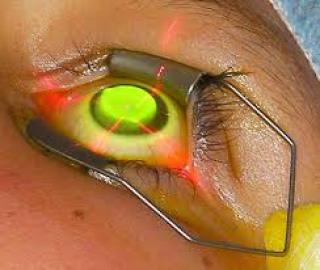
Corneal Cross-Linking
Corneal cross-linking (CXL) is a treatment which prevents keratoconus getting worse. Keratoconus is a noninflammatory eye condition in which the normally round dome-shaped clear window of the eye (cornea) progressively thins, causing a cone-like bulge to develop. CXL treatment is successful in more than 90% of cases. After treatment, you will still need to wear spectacles or contact lenses. Your eye will be sore for a few days after the procedure. Although vision is often hazy at first, most patients can return to work after one week. As with all operations, there are risks: CXL is safe, but there is a small chance (less than 3%) of a reduction in vision afterwards.
The treatment is usually recommended only for patients whose corneal shape scans show that their keratoconus is getting worse. In order to obtain the most accurate scans, we ask that you remove your contact lenses prior to your scan (two weeks for hard contact lenses, one week for soft contact lenses).
What evidence is there that it works?
Collagen cross-linking is the only treatment currently available that appears to stop keratoconus from getting worse. Evidence from three randomised clinical trials one year after CXL showed success in halting keratoconus progression in more than 90% of treated eyes. Longer term results (up to 10 years) from different studies suggest a similarly high success rate in preventing keratoconus progression. Moorfields’ own results since 2013 when we began treating patients with CXL show a success rate of approximately 94%, with less than 1% requiring a repeat CXL treatment.
What happens during CXL?
CXL is performed as a day-case procedure that usually takes less than 30 minutes. During the procedure, you will be asked to lie flat on the treatment table. Anaesthetic drops are used to numb the surface of your eye before a small clip is placed to keep your eyelids open. The surface skin of your eye (epithelium) is gently brushed clear and riboflavin drops are applied every few minutes for at least ten minutes. Following this, the ultraviolet light is shone at your eye for eight minutes. A soft ‘bandage’ contact lens is placed on your eye at the end of the procedure.
What happens after CXL?
You will be given eye drops to use after the procedure. The soft ‘bandage’ contact lens will remain in your eye until the surface has healed (about seven days).
Do I need to take time off work or studies?
Yes. You should allow at least one week off while most of the surface healing occurs, or two weeks if your job involves a lot of computer work and the treatment is being done on your better eye. You will be putting eye drops in every hour for the first day, and then every four hours for the following days. If you have exams or other important timelines over the coming months please let us know, as it may be more appropriate to postpone your treatment until afterwards. Day to day activities such as watching TV or using a computer will not do any damage to your eye, but you might find it more comfortable to rest with your eyes closed early on. You will be given an appointment the following week to check your eye is healing properly.
What are the risks of CXL?
In general, CXL is very safe, but like all operations your eye needs time to heal and problems may rarely occur. Less than 3% of patients may lose some vision in the treated eye. This may improve spontaneously; in rarer cases where there is infection or scarring, this visual loss is potentially reversible with a corneal transplant. Remember that without CXL treatment; at least 20% of all patients with keratoconus will eventually require a corneal transplant. The risk of transplantation for patients whose keratoconus is progressing is probably higher.
For further information please make an appointment as soon as possible for your assessment with Mr Saldanha to establish your eligbility to undergo Cross-Linking.

